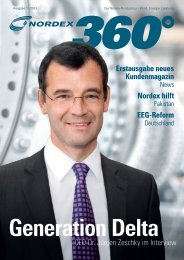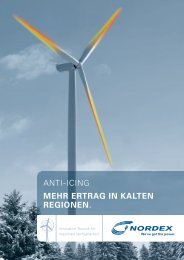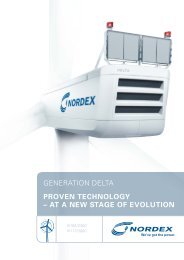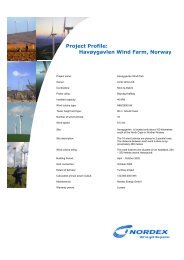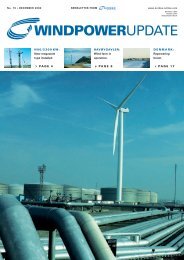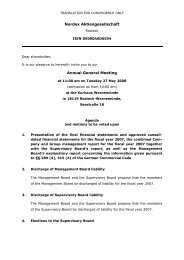OFFERING MEMORANDUM Global Offering of up to ... - Nordex
OFFERING MEMORANDUM Global Offering of up to ... - Nordex
OFFERING MEMORANDUM Global Offering of up to ... - Nordex
You also want an ePaper? Increase the reach of your titles
YUMPU automatically turns print PDFs into web optimized ePapers that Google loves.
Market Environment and Regula<strong>to</strong>ry Background<br />
The market environment for the manufacture and sale <strong>of</strong> wind turbines is characterized by a range <strong>of</strong><br />
environmental and regula<strong>to</strong>ry fac<strong>to</strong>rs, some <strong>of</strong> which vary greatly at a regional and national level.<br />
Fac<strong>to</strong>rs having a significant effect <strong>up</strong>on the market environment are: the local wind conditions (wind<br />
regime), as wind turbines can only be operated economically in regions with appropriate wind<br />
conditions (see ‘‘Business—Technical Background’’), and state subsidies provided for generating<br />
electricity from wind energy.<br />
The costs <strong>of</strong> generating electricity using wind energy can currently only compete with the costs <strong>of</strong><br />
generating electricity from non-renewable energy sources in regions with excellent wind conditions,<br />
such as the coastal regions <strong>of</strong> Denmark and the UK. It is not possible <strong>to</strong> predict if and when the costs <strong>of</strong><br />
generating electricity using wind energy in non-coastal regions, such as Germany, will be able <strong>to</strong><br />
compete with the costs <strong>of</strong> generating electricity from conventional energy sources. In most regions,<br />
accordingly, electricity generation depends on state s<strong>up</strong>port for wind turbine opera<strong>to</strong>rs <strong>to</strong> be able <strong>to</strong><br />
run their farms economically. This s<strong>up</strong>port depends on the relevant environmental policies and on<br />
specific wind conditions in the region.<br />
Furthermore regional markets are at varying degrees <strong>of</strong> maturity – although there are already a large<br />
number <strong>of</strong> wind turbines in operation in Germany, Denmark, The Netherlands and the US that have<br />
been erected over the last 10 years, the market for wind turbines in Spain, Greece, Egypt and China has<br />
grown, inter alia, in the last 2-3 years as these countries have introduced subsidies. The nominal output<br />
required by the various markets corresponds <strong>to</strong> the relevant market’s degree <strong>of</strong> maturity. In Germany,<br />
for example, the greatest demand is for turbines with a high nominal output, whereas in markets<br />
where the electricity generation by way <strong>of</strong> wind turbines is still in its early stages, demand is for smaller<br />
turbines with a lower nominal output. In this regard, it should also be taken in<strong>to</strong> consideration that<br />
establishing and operating high output wind turbines, such as the <strong>Nordex</strong> N-80 model, requires<br />
sophisticated infrastructure such as fully developed road connections, heavy lifting cranes, etc. (see<br />
‘‘Business—Logistics’’).<br />
<strong>Global</strong>ly, the market for wind turbines depends on a small number <strong>of</strong> international manufacturers <strong>of</strong><br />
wind turbines and accordingly, other local manufacturers have a large number <strong>of</strong> opera<strong>to</strong>rs as<br />
potential cus<strong>to</strong>mers (see ‘‘Business—Competition’’).<br />
Environmental Policy – Background<br />
The Earth does not have an unlimited s<strong>up</strong>ply <strong>of</strong> fossil energy sources such as oil and gas which are<br />
used currently, and generating electricity from fossil energy sources releases carbon dioxide (CO2),<br />
which is thought <strong>to</strong> be responsible for the so-called greenhouse effect.<br />
In order <strong>to</strong> combat the greenhouse effect at a global level, the Kyo<strong>to</strong> Climate Summit was held in 1997<br />
<strong>to</strong> further implement the commitments agreed <strong>up</strong>on at the Rio Earth Summit in Rio de Janeiro, Brazil.<br />
According <strong>to</strong> the minutes <strong>of</strong> the Kyo<strong>to</strong> Summit, the participating countries agreed <strong>to</strong> a long-term<br />
reduction <strong>of</strong> their CO 2 emissions. The minutes contain, inter alia, a resolution which provides that by<br />
2010, all countries signing the minutes would reduce their CO2 emissions by an average <strong>of</strong> 5%<br />
compared <strong>to</strong> the level <strong>of</strong> emissions for 1990. In addition, countries <strong>of</strong> the European Union entered in<strong>to</strong><br />
an agreement <strong>to</strong> reduce CO2 emissions in 1998. As a result, the Federal Republic <strong>of</strong> Germany has <strong>to</strong><br />
reduce its CO2 emissions by <strong>up</strong> <strong>to</strong> 21% by 2010. In order <strong>to</strong> reach this target, the Gesetz über den<br />
Vorrang erneuerbarer Energien (The Act on Granting Priority <strong>to</strong> Renewable Energies (EEG)) came in<strong>to</strong><br />
effect in Germany on April 1, 2000. At European level, the Altener Program was implemented on<br />
February 28, 2000 (Decision No. 646/2000/EC <strong>of</strong> the European Parliament and the European Council).<br />
This long-term program introduced a comprehensive concept for the promotion <strong>of</strong> renewable energy.<br />
In contrast <strong>to</strong> fossil energy sources and nuclear energy, wind power is clean, inexhaustible and freely<br />
available. As a result, with the exception <strong>of</strong> investment costs, the costs <strong>of</strong> operating wind turbines are<br />
comparatively low. In the Company’s view, wind energy thus represents a promising future market.<br />
28



